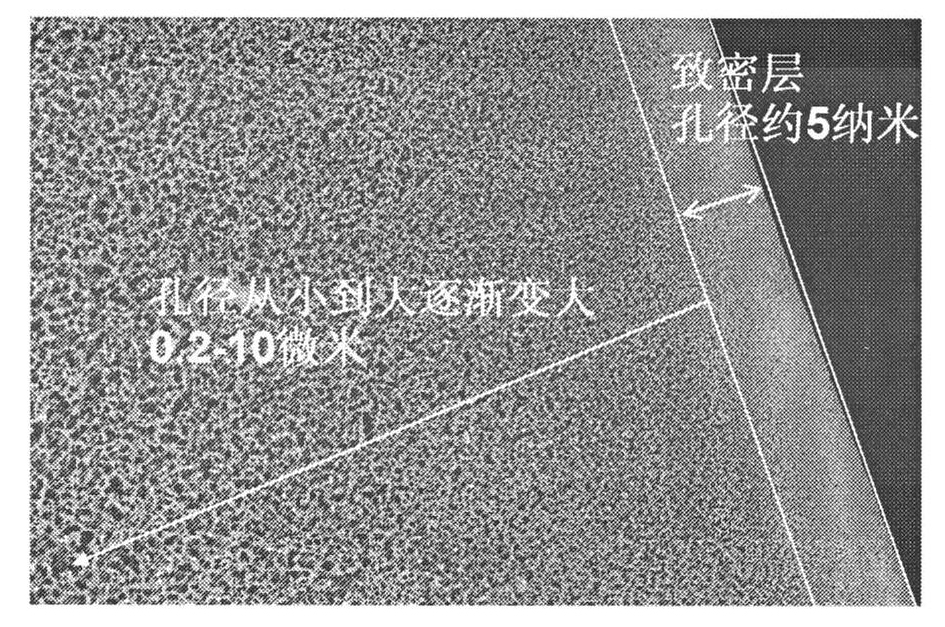Hydrophilic film material and preparation method thereof
A technology of hydrophilic membrane and membrane material, applied in chemical instruments and methods, membrane technology, semi-permeable membrane separation, etc., can solve the problems of anti-pollution performance and insufficient hydrophilic performance, achieve strong hydrophilic performance and reduce usage , Improve the effect of performance
- Summary
- Abstract
- Description
- Claims
- Application Information
AI Technical Summary
Problems solved by technology
Method used
Image
Examples
Embodiment 1
[0031] 20 grams of polyethersulfone, 8 grams of polyethylene glycol (weight-average molecular weight: 200,000 Daltons), dissolved in 75 grams of dimethylacetamide and 6 grams of n-butanol (additive) mixed solvent at 100 ° C and fully stirred In , the proximity ratio α of the solution is 0.75. After the polymer was completely dissolved, it was filtered through a stainless steel mesh with a pore size of 40 microns and left to stand in an oven at 100°C for defoaming. Using a stainless steel spatula with a thickness of 200 microns, the polymer solution was applied to a glass plate, placed in air (25°C, relative humidity 60%) for about 10 seconds, then immersed in 45°C water for phase separation and solidification. After the membrane material is completely cured, take out the membrane material for further cleaning. After cleaning, the membrane material was soaked in potassium persulfate solution with a concentration of 8000ppm for 6 hours for post-treatment, and then the pure wate...
Embodiment 2
[0033] 20 grams of polysulfone, 8 grams of polyethylene glycol (weight average molecular weight 200,000 Daltons), dissolved in 75 grams of dimethylacetamide and 6 grams of diethylene glycol (additive) mixed solvent at 80 ° C and fully stirred In , the proximity ratio α of the solution is 0.56. After the polymer was completely dissolved, it was filtered through a stainless steel mesh with a pore size of 40 microns and left to stand in an oven at 100°C for defoaming. Using a stainless steel spatula with a thickness of 200 microns, the polymer solution was applied to a glass plate, placed in air (25°C, relative humidity 60%) for about 10 seconds, then immersed in 40°C water for phase separation and solidification. After the membrane material is completely cured, take out the membrane material for further cleaning. After cleaning, the membrane material was immersed in a hydrogen peroxide solution with a concentration of 6000ppm for 12 hours for post-treatment, and then the pure w...
Embodiment 3
[0035] 18 grams of polyetherimide and 15 grams of cellulose acetate were dissolved in 65 grams of nitrogen methylpyrrolidone and 25 grams of PEG400 mixed solvent at 120° C. with sufficient stirring. After the polymer is completely dissolved, it is filtered through a stainless steel mesh with a pore size of 40 microns and left to defoam. The proximity ratio α of the solution is 0.5. Using a stainless steel spatula with a thickness of 300 microns, the polymer solution was applied to a glass plate, placed in air (22°C, relative humidity 55%) for about 2 seconds, and then immersed in 30°C water for phase separation and solidification. After the membrane material is completely cured, take out the membrane material for further cleaning. After cleaning, the membrane material was soaked in a potassium persulfate solution with a concentration of 50000ppm for 4 hours for post-treatment, and then the pure water permeability of the membrane was measured to be 550L m -2 ·hr -1 · bar -1...
PUM
| Property | Measurement | Unit |
|---|---|---|
| Aperture | aaaaa | aaaaa |
| Surface aperture | aaaaa | aaaaa |
| Outer diameter | aaaaa | aaaaa |
Abstract
Description
Claims
Application Information
 Login to View More
Login to View More - R&D
- Intellectual Property
- Life Sciences
- Materials
- Tech Scout
- Unparalleled Data Quality
- Higher Quality Content
- 60% Fewer Hallucinations
Browse by: Latest US Patents, China's latest patents, Technical Efficacy Thesaurus, Application Domain, Technology Topic, Popular Technical Reports.
© 2025 PatSnap. All rights reserved.Legal|Privacy policy|Modern Slavery Act Transparency Statement|Sitemap|About US| Contact US: help@patsnap.com



